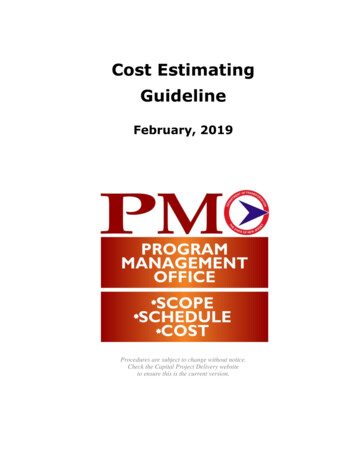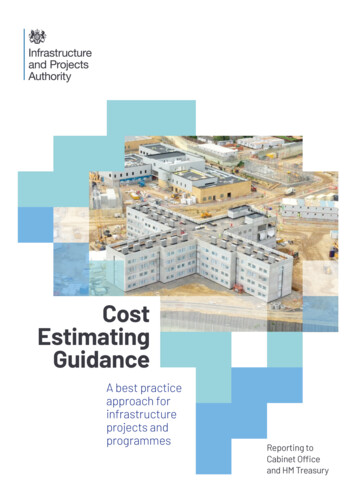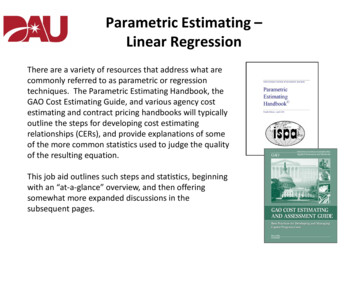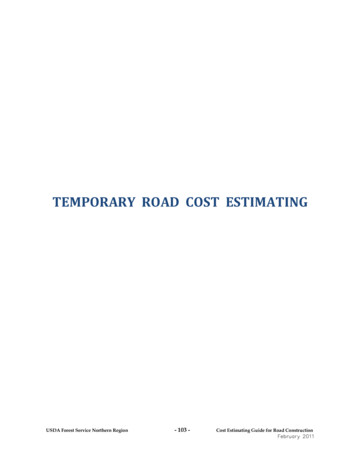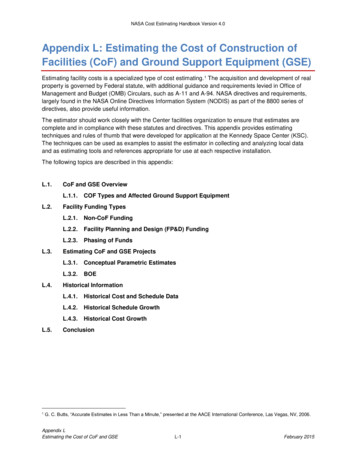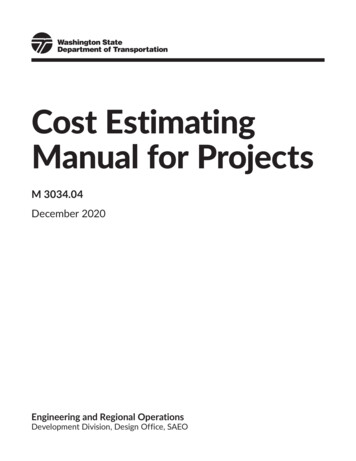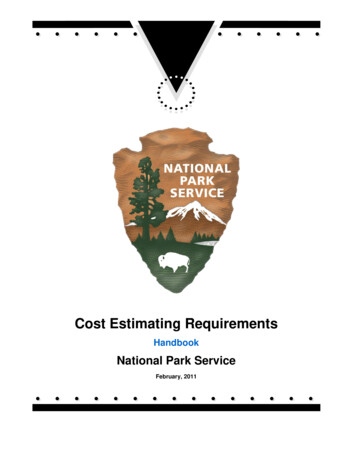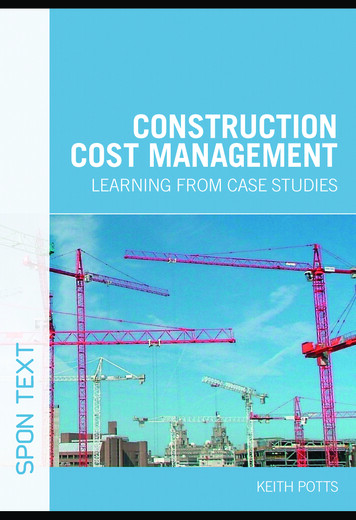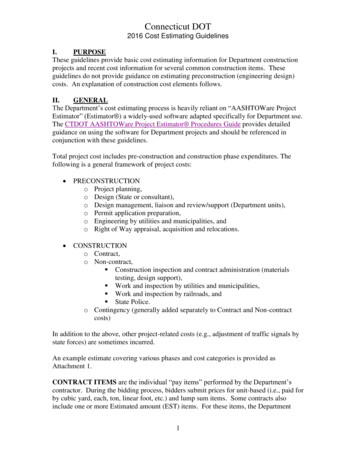
Transcription
Connecticut DOT2016 Cost Estimating GuidelinesI.PURPOSEThese guidelines provide basic cost estimating information for Department constructionprojects and recent cost information for several common construction items. Theseguidelines do not provide guidance on estimating preconstruction (engineering design)costs. An explanation of construction cost elements follows.II.GENERALThe Department’s cost estimating process is heavily reliant on “AASHTOWare ProjectEstimator” (Estimator ) a widely-used software adapted specifically for Department use.The CTDOT AASHTOWare Project Estimator Procedures Guide provides detailedguidance on using the software for Department projects and should be referenced inconjunction with these guidelines.Total project cost includes pre-construction and construction phase expenditures. Thefollowing is a general framework of project costs: PRECONSTRUCTIONo Project planning,o Design (State or consultant),o Design management, liaison and review/support (Department units),o Permit application preparation,o Engineering by utilities and municipalities, ando Right of Way appraisal, acquisition and relocations. CONSTRUCTIONo Contract,o Non-contract, Construction inspection and contract administration (materialstesting, design support), Work and inspection by utilities and municipalities, Work and inspection by railroads, and State Police.o Contingency (generally added separately to Contract and Non-contractcosts)In addition to the above, other project-related costs (e.g., adjustment of traffic signals bystate forces) are sometimes incurred.An example estimate covering various phases and cost categories is provided asAttachment 1.CONTRACT ITEMS are the individual “pay items” performed by the Department’scontractor. During the bidding process, bidders submit prices for unit-based (i.e., paid forby cubic yard, each, ton, linear foot, etc.) and lump sum items. Some contracts alsoinclude one or more Estimated amount (EST) items. For these items, the Department1
Connecticut DOT2016 Cost Estimating Guidelinesdesignates the contract amount, generally because the required work is not sufficientlydefined to solicit binding bids. The established amount is included on the bid proposalform and part of each bidder’s bid amount. The actual amount paid for an Estimatedamount item is determined during construction based on actual requirements.Estimator is the principal tool used to estimate contract unit-based items. Much of theprocedural detail associated with using Estimator is provided in the CTDOTAASHTOWare Project Estimator Procedures Guide. Estimator has severallimitations, including: It does not generate estimated prices for lump sum or Estimated (EST) items.It does not generate estimated non-contract costs (e.g., utilities, state police).It does not generate estimated prices for unit-based items unless the item was usedin at least two previous construction contracts within the selected catalog.If the selected bid history catalog has between 2 and 14 occurrences of the sameitem, the Estimator price will be the average of those prices. No project-specificfactors are accounted for.If the selected bid history catalog includes 15 or more occurrences of the sameitem, the Estimator price will be a regression on several factors (quantity,location, letting date, work type). However, other factors affecting bidder prices(e.g., schedule constraints, difficult site conditions) are not accounted for.Because of these limitations, the estimator needs to prepare some prices using otherinformation. Additionally, sometimes the estimator should override the price generatedby Estimator .NON-CONTRACT ITEMS represent Department expenses for work required tocomplete the project but not included in the contract. Specific elements comprising thiscategory are discussed below.Incidentals – the cost of Construction Engineering (CENG), which consists of thevarious activities required to administer the construction contract, includinginspection, materials testing, construction phase design support and otherfunctions. It includes state and consultant forces, when applicable. For stateawarded construction contracts, this “Incidental Cost” is estimated using a slidingscale percentage of the contract cost in accordance with a Chief Engineer’smemorandum (dated January 10, 2014), provided as Attachment 2. Include theestimated amount in the Estimator file. For contracts awarded by local publicagencies, refer to the Chief Engineer’s memorandum dated August 14, 2009(Attachment 3).Utility Agreements and Railroad Relocation and Protection – costs incurredby public utilities and railroads required by the project, such as for relocation ofpublic utilities or interference with railroads (by physical alteration or occupationof their property). During project development, written agreements between the2
Connecticut DOT2016 Cost Estimating GuidelinesDepartment and each affected utility and railroad are developed and executed tocover the estimated cost of relocation and protection. Identify all agreements andthe associated amount(s) from the Utilities Section of the Division of Facilitiesand Transit and include them in the Estimator file.State Police – the cost of dedicated patrol and traffic control for selected projectsas determined by the Division of Traffic Engineering. This cost is attributable tothe project but is not a contract item or cost. The cost is paid by the Departmentthrough an interagency Memorandum of Understanding. The estimated amount isincluded in the Estimator file.Estimator (software) provides no assistance in estimating the three cost categories notedabove. The estimated costs for these items should be developed ‘offline’ and entered intoEstimator CONTINGENCY is the estimated cost associated with risk and uncertainty. It is usuallyestimated as a percentage of anticipated costs. Uncertainty and risk diminish asdevelopment progresses toward design completion, so contingency also decreases asdesign development advances. Contingencies are applicable to both contract and noncontract costs. However, these guidelines only provide specific guidance on establishingcontingency values for contract costs. See the next section “Cost Estimates DuringProject Development” for specific guidance.COST ESIMATES DURING PROJECT DEVELOPMENTAll construction cost estimates should be updated twice per year, at major designmilestones (Preliminary Design, Semi-Final Design, Final Design for Review and FinalDesign Plans) and when the scope is changed significantly.The various elements of the estimated contract cost are shown in the figure below. Thebase estimate is composed of what can be reasonably ‘known’ about the cost ofconstruction when the estimate is prepared. This base estimate includes the cost ofindividual work items at the current/recent prices that have been identified. Additionally,in early phases of development, a minor item allowance is used to account for items thatare known to be required but are too small to account for individually. This allowance ispart of the base estimate. As previously noted, contingency is the cost associated withrisk and uncertainty. An amount is computed and included in the estimate to cover theprobable cost of work that cannot be reasonably known – but will probably be needed.Construction cost estimates are intended to represent Department disbursements(amounts paid out) to construct a project. As labor and material costs change over time,the cost of construction also changes. All estimates should identify a correspondingreference time (month and year). For fiscal management and capital planning purposes,anticipated disbursements (dollars paid out) should be shown in the “year ofexpenditure.” Inflation refers to the general trend of increasing cost with time. An3
Connecticut DOT2016 Cost Estimating Guidelinesadjustment is generally needed to account for inflation between the cost computed usingcurrent/recent prices and future (i.e., year of expenditure) disbursements.The various elements of a construction contract cost estimate in relation to major projectdevelopment milestones are shown in Figure 1. The minor item allowance, contingencyand inflation adjustment decrease as project definition is completed, all payment itemsare identified and costs reflect current prices. Further guidance on estimating individualelements of the construction contract cost follows.Figure 1. Components of construction contract cost by development gencyContingencyMinor ItemAllowanceMinor ItemAllowanceMinor ItemAllowanceBase EstimateEstimated Contract signDevelopment Phase4IdentifiedItemsFinalDesign
Connecticut DOT2016 Cost Estimating GuidelinesThe base estimate is the estimated cost of anticipated contract work, as contemplated atthe time of the estimate and in the current price environment. The estimator may useindividual “catalog pay items” found in the Department’s bid history (available throughEstimator ), aggregate cost factors (e.g., cost/unit of area) or other methods (e.g., costbasis). Aggregate cost factors are discussed in a subsequent section. Additionally, aminor item allowance should be included using the factors indicated in Table 1. Theestimator needs to make a judgment in selecting a value from within the noted range.The selected percent value is multiplied by the cost of identified items as noted in thetable. No minor item allowance is included in the final estimate, since all work should becovered by individual catalog items and quantities.Table 1. Minor item and contingency factor guidance.Minor Item AllowancePhaseProgrammingFactor(%)15 - 30Preliminary Design10 - 20Semi-Final Design5 - 10Final Design0Multiply byRoadway & Structure itemsRoadway, Structure, EnvironmentalCompliance & Traffic itemsAll identified itemsNot applicableContingencyFactor Multiply(%)by20 - 30Base15 - 25Base10 - 20Base10BaseThe contingency element of contract cost is computed by applying the selectedcontingency percentage to the base estimate (identified items plus minor item allowance).Table 1 indicates a range of recommended contingency factors. The ranges shown areassociated with project complexity. The lower end of the range is appropriate for lowcomplexity projects and vice versa. Typical risk factors include uncertain scope,subsurface work and mitigation measures. At final design, a contingency factor of 10percent is used in accordance with a Chief Engineer’s memorandum (January 10, 2014),and included in the Estimator file.Estimates are usually based on recent bid prices. Unless inflation is rampant (more than10 percent annually), prices based on the most-recent three years are generally adequatefor contracts with an imminent letting (i.e., bid opening). However, when the letting ismore than a year from when the estimate is prepared, an inflation adjustment should beincluded.There are basically two methods that can be used to adjust cost based on timing. One isthrough Estimator . This software is most useful when all of the contract items andquantities are defined. When this information and the scheduled letting date are availableand entered in Estimator , the estimated costs generated by Estimator willautomatically factor time into estimated cost (i.e., account for inflation). Estimator computes price trends for individual items and projects costs up to the specified “base5
Connecticut DOT2016 Cost Estimating Guidelinesdate.” This adjustment is made automatically only for the unit-based items estimated byEstimator . This approach is generally not workable for preliminary estimates.The second method, and the one recommended for preliminary estimates, is to adjust forinflation by direct calculation. Except for contracts with durations of three years ormore, the inflation adjustment factor is computed by determining the number of yearsbetween the estimate date (when estimate is prepared) and scheduled bid opening andmultiplying this number by the annual inflation factor. For contracts with durations ofthree years or longer, compute the number of years from the estimate date to the midpoint of construction. An annual inflation rate of 5 percent per year (simple, notcompound) should be used for 2016 and subsequent years. Example computations follow.Inflation Example 1 (construction duration less than 3 years)Estimate date: January 15, 2016Scheduled bid opening (letting) date: November 16, 2017Duration of construction contract: 2 years (midpoint: April 2019)Estimated cost: 1,500,000Inflation: 5 percentEstimated future/inflated cost 1,500,000 x (1.0 1.83 x 0.05) 1,637,250Inflation Example 2 (construction duration more than 3 years)Estimate date: January 15, 2016Scheduled bid opening (letting) date: December 14, 2017Duration of construction contract: 4 years (midpoint: April 2020)Estimated cost: 15,000,000Inflation: 5 percentEstimated future/inflated cost 15,000,000 x (1.0 4.25 x 0.05) 18,187,500It should also be noted that inflation affects various project cost categories (e.g., rights ofway, construction) differently since they are incurred at different points in time and haveunique cost trends. The guidance and examples in this section apply only to constructioncontracts.IV.AGGREGATE COSTS FOR PRELIMINARY ESTIMATES,This section provides guidance for the preliminary estimation of several commonconstruction features that are comprised of many individual contract items. The cost ofthese construction features cannot be obtained directly from bid history or Estimator .The advantage of using these aggregate average costs is that they capture manyindividual contract items without preparing a detailed design and computing the specificitems and quantities that will be required. However, it should be recognized that costsvary significantly by project. Some costs are far higher than the average and some aresignificantly less. These average costs are most appropriate for scoping estimates.6
Connecticut DOT2016 Cost Estimating GuidelinesBridgesTable 2, and associated notes, provide average costs for various categories of bridgework. Most of the information was developed by the Department’s Bridge Managementunit.Retaining WallsThe average unit costs are based on lump sum costs for wall divided by the area (lengthtimes height, measured from the top of footing to the top of wall).Average: 125/square footExpected range: 80 – 150/square footEmbankment WallsAverage: 70/square footExpected range: 30 – 90/square footRoadway LightingExpressway: 55/linear footRamps: 40/linear footIndividual Highway Pole & Light: 9,500SignalizationPermanent Signal SystemsState HighwayLocally-owned Signal SystemMinor ModificationMajor ModificationTemporary SignalizationM&PT Bridge ProjectsExisting SignalUtility Relocation for Signalization ProjectsRectangular Rapid Flashing Beacon (RRFB)HAWKTemporary Detection 150,000 - 180,000/intersection 225,000 - 250,000/intersection 30,000/intersection 80,000/intersection 35,000/intersection 2,500/intersection 7,000/intersection 15,000 - 25,000/crossing location 90,000/location 2,500/intersectionV.LUMP SUM CONTRACT ITEMSThis section provides guidance for several common construction features that aretypically bid as lump sum items.Structural SteelThe prices of lump sum structural steel items [e.g., Structural Steel, Structural Steel (SiteNo. )] includes both material and its installation. Cost is estimated on the basis ofweight, using the values (which include material and cost):Average: 2.50/lbAbove 10,000 lbs and favorable site conditions: 2.25/lbBelow 10,000 lbs or less-than favorable site conditions: 3.00 - 10.00/lb7
2016 Cost Estimating GuidelinesTable 2. Estimated cost of common bridge work.Estimating Unitssquare feet of replacement bridge (2)square feet of replacement bridge (2)square feet of deck removed (3)square feet of deck removed (3)square feet of deck area replacedsquare feet of deck area replacedsquare feet of deck area replacedsquare feet of deck area rehabilitatedlinear feet of girder replacedsquare feet of substructure repairsquare feet of deck area replacedsquare feet of deck area rehabilitatedlinear feet of joints repairedeach beam end repairedsquare feet of area repaintedsquare feet of steel area cleanedEach bearing replacedsquare feet of deck areasquare feet of deck area (4)square feet of deck area (4)Unit Cost( 0081202258Description of WorkTotal Replacement of Bridge Structure to New Standards: On-system (1)Total Replacement of Bridge Structure to New Standards: Off-system (1)Removal of Superstructure (over roadway)Removal of Superstructure (over water or rail)Replacement of Bridge Superstructure: Deck Area 1600 square feetReplacement of Bridge Superstructure: 1,600 sq ft Deck Area 11,000 sq ftReplacement of Bridge Superstructure: Deck Area 11,000 square feetRehabilitation of Existing SuperstructureReplace Bridge Girder(s)Repair or Modify Bridge SubstructureReplace Bridge DeckRehabilitate Bridge DeckReplace Bridge JointsRepair Bridge Beam EndsBridge Touch Up PaintingBlast Cleaning and Field Painting of BridgeReplace Bridge BearingsInstall or Replace Bridge Bit Wearing Surface and Waterproof MembraneRepair/Rehabilitate CulvertReplace CulvertNotes:1. On-system means the bridge is on a Federal-aid route, which are all roads except those functionally classified as a local road or ruralminor collector (use functional classification maps, not state/municipal ownership). Off-system includes everything that is not “Onsystem”. The costs are for the replacement bridge only and do not include other work such as demolition of existing structures,constructing approaches, retaining walls, traffic control and other general contract items (e.g., mobilization, construction staking).2. Compute the area by multiplying the out-to-out width times the length of the new/replacement (i.e., not existing) bridge.3. Use the area of the existing bridge.4. Compute the area for culverts by multiplying the entire end-to-end (direction of flow) length times the inside dimension width(perpendicular to flow).Connecticut DOT
Connecticut DOT2016 Cost Estimating GuidelinesRecurring Lump Sum ItemsThe four items addressed in this section are included in many projects. For a specificcontract, individual bids for these items often vary widely. Given the variability inbidding strategies along with the requirements for specific projects, average dollar valuesshould not be used for contract estimates. Instead, the cost of these items should beestimated as a percentage of total project cost. Table 3 summarizes recent bid history forsingle-location highway and bridge construction contracts. These percentages are notnecessarily representative of contracts primarily or exclusively for area-wide specialtywork (bridge repair, pavement marking, rumble strips, signing, signals), buildingconstruction or aviation. When estimating these types of contracts, review previoussimilar contracts.Table 3. Range and average percentage for recurring lump sum item costs.ItemNumberPercent of total bidDescriptionAverageRange0201001Clearing and Grubbing2.00.5 – 6.00971001Maintenance and Protection of Traffic3.00.5 – 6.00975002Mobilization and Project Closeout6.53.5 – 10.00980001Construction Staking1.00.2 – 3.0Accurate estimation of these items is difficult since bidders’ prices often reflect factorsnot directly related to the work entailed by the item. Consequently, average values areoften appropriate. However, prices should also consider certain historical trends andpractical considerations as discussed below.The estimated cost of Clearing and Grubbing should reflect the extent of the effort.Some project types (e.g., realignment) inherently involve more clearing effort than others(e.g., IMS). Some types of work (bridge rehabilitation) vary widely within the samecategory. The estimator should select a percentage that is representative of the clearingand grubbing effort, generally within the range shown in Table 3.Bid prices for Maintenance and Protection of Traffic tend to be high (more than 10percent of total bid) for multi-location bridge repair contracts (e.g., expansion joint, plugjoints, beam end). Traffic signal, pavement preservation, intersection improvement andsingle-location bridge rehabilitation contracts tend to be on the lower end of the range (2percent or less of the total bid).Bids for Mobilization and Project Closeout (as a percent of total bid) are less volatilethan the other recurring lump sum items. Multi-location bridge repair contracts (beamends, bearings, joints) tend to be higher (10 percent and above). Mobilization for thesecontracts should be estimated at 10 percent of the total contract and the average value(6.5 percent) is recommended for all other contracts.9
Connecticut DOT2016 Cost Estimating GuidelinesBids for Construction Staking tend to be fairly logical, generally related to the level ofeffort. This item is generally 2 percent or more of the total bid for realignment andwidening of existing facilities and bridge replacement contracts. For pavementpreservation, bridge rehabilitation and traffic signal contracts, this item is generallyaround 0.5 percent of the contract. For all other contracts, the average (1 percent) isrecommended.VI.OTHER COSTSRailroad ProtectionFlagging:Metro North and Amtrak: 1,000/man/shiftOther railroads: 800/man/shiftDe-energizing: 5,000/Flagman and groundman/shiftOn-site Traffic Control PersonnelState Police Officer: 85/hour (not a contract item)Town (City) Police Officer: 75/hour (contract item, Estimated amount)Uniformed Flagger: 55/hour (contract item, bid unit price)For preliminary estimating guidance on other construction costs, consult with relevantfunctional divisions and units (Traffic Engineer, Utilities, Environmental Compliance).VII. FINAL ESTIMATESFinal Estimates serve as the basis for detailed fiscal actions (e.g., obligating federal andmatching funds) and for analyzing contractor bid proposals. Final Design Plan (FDP)estimates should identify contract costs, non-contract costs and a contingency as shownunder the “Construction” heading in the “General” section (p. 1).The Digital Project Development Manual and the CTDOT AASHTOWare ProjectEstimator Procedures Guide provide detailed information related to the submission ofFDP estimates. This guide also includes guidance on how a “lead” unit (e.g., Highway,Structures) can assemble a project-level estimate by adding together discipline subsets(i.e., roadway, bridge, traffic) and electronic processing options (Estimator direct entry,uploading Excel files).VIII. RECENT BID PRICES FOR COMMON CONTRACT ITEMSEstimator is the best source of estimated unit prices. If a unit-based item is included ina sufficient number of recent contracts (3 or 5 years, depending on the selected catalog),the software will develop a unit price as described in the “General” section of theseguidelines. Therefore, Estimator is the generally preferred source of unit costs.However, Attachment 4 is provided as a quick source of ‘ball park’ unit price ranges.The ranges provided reflect expected range, as opposed to the absolute range (minimum10
Connecticut DOT2016 Cost Estimating Guidelinesand maximum bids) for these items. It is not unusual for a bid to fall outside the rangesshown. Typically, unit prices decline as quantities increase. Factors such as siteconstraints, schedule and location also affect bid prices and should be considered inestimating unit costs. This information (i.e., Attachment 4) should never be used as theprimary basis for developing final estimates.For additional information on construction cost estimating for Department-administeredprojects, contact Mr. Robert Neville (594-3245), Mr. Mark Stopper (594-3248), Mr.James Kocaba (594-2689) or Mr. David Montefiore (594-2498) in the Cost Estimatingsection.Attachments1. Example Estimate2. Chief Engineer Memorandum, January 10, 20143. Chief Engineer Memorandum, August 14, 20094. General Price Ranges of Common Items11
Connecticut DOT2016 Cost Estimating GuidelinesAttachment 1 - Example EstimatePROJECT NO. 123-456Anticipated year of expenditure:Base year (cost is based on expenditure in this year):Phase of Development:2016Inflation (%) 52014Preliminary DesignTOTAL COST SUMMARYACTIVITYESTIMATED 20600,000125,0001,331,030187,000PRELIMINARY DESIGNRIGHT OF WAY (PRE-ACQUISITION)UTILITIES (ENGINEERNIG)RAILROAD (ENGINEERING)FINAL DESIGNRIGHT OF WAY (ACQUISITION)CONSTRUCTION CONTRACTUTILITIES (CONSTRUCTION)RAILROAD (CONSTRUCTION)INCIDENTALS (CENG)STATE POLICEYEAR OFEXPENDITURESTATE 20162016201620162016All costs include contingencies and inflation to year of expenditureCONTRACT COST SUMMARY%ROADWAY (See breakout, separate sheet)STRUCTURES (See breakout, separate sheet)ENVIRONMENTAL COMPLIANCE (See breakout, separate sheet)TRAFFIC (See breakout, separate sheet)SUBTOTAL (IDENTIFIED WORK)MINOR ITEMS15TOTAL (IDENTIFIED WORK)Estimated based on % total contract costCLEARING & GRUBBINGM & P OF TRAFFICCONSTRUCTION 09ESTIMATED COST OF CONTRACT IN BASE YEAR 5,324,120ESTIMATED COST OF CONTRACT WITH INFLATIONESTIMATED BY: Tom SmithUNIT: 1305DATE: 7/20/20152,649,979%CONTRACT WORKCONTINGENCYINCIDENTAL COST1,866,929649,15021,900112,000REVIEWED BY: John BrownUNIT: 1305DATE: 8/14/2015
Connecticut DOT2016 Cost Estimating GuidelinesAttachment 1 - Example EstimatePROJECT NO.123-456STRUCTUREBASIS FOR ESTIMATECOSTLENGTHWIDTH# OF UNITS UNIT COSTCOSTDESCRIPTIONREPLACE BRIDGE 1234 (Estimate SF)RETAINING WALL (Estimate URE SUBTOTALTRAFFICDESCRIPTIONDAYSUNIFORMED FLAGGERBASIS FOR ESTIMATECOSTHOURS/DAY # OF UNITS UNIT COSTCOST1758TEMPORARY SIGNALIZATION (LS)1,40015577,00035,00035,000112,000TRAFFIC SUBTOTALENVIRONMENTAL COMPLIANCEDESCRIPTIONRSA/WSA EQUIPMENT OPERATORDISPOSAL OF CONTROLLED MATERIALSCONTROLLED MATERIALS HANDLINGBASIS FOR ESTIMATECOSTUNITS# OF UNITS UNIT COSTCOSTHOURTONCYENVIRONMENTAL COMPLIANCE SUBTOTAL1202001007060158,40012,0001,50021,900
Connecticut DOT2016 Cost Estimating GuidelinesAttachment 1 - Example EstimatePROJECT NO.123-456ROADWAYBASIS FOR ESTIMATEDESCRIPTIONCOSTUNIT COSTCOSTUNITS# OF UNITSEARTH EXCAVATIONCHANNEL EXCAVATIONROCK EXCAVATIONFORMATION OF SUBGRADESUBBASEHMA S0.5CONCRETE CURBINGSTAMPED CONCRETE (TRUCK APRON)TEXTURED CONCRETE MEDIANCONCRETE SIDEWALKMETAL BEAM RAIL (TYPE R-B 350)WOOD PLANK RAILBITUMINOUS CONCRETE DRIVEWAYFURNISHING AND PLACING TOP SOILMILLING OF HMA (0" TO 4")REMOVAL OF CONCRETE PAVEMENTCATCH BASINS12" RCP15" RCP18" RCP18" RCCERIPRAPTRENCH EXCAVATION 0'-10' 0028,60022,10031,5002,60015,75030,800FIELD OFFICE, MEDIUMMO163,00048,000LANDSCAPINGBUILDING DEMOILLUMINATIONWETLAND 00,00015,000100,00015,000100,000ROADWAY SUBTOTAL1,866,929
Attachment 2; Chief Engineer Memorandum; January 10, 2014
Attachment 3; Chief Engineer Memorandum; August 14, 2009
Connecticut DOT2016 Cost Estimating GuidelinesAttachment 4 - General Price Ranges of Common ItemsItem No.Item 01306510150651017CONTROLLED MATERIALS HANDLINGPOLE FOUNDATIONS, TYPE AEARTH EXCAVATIONROCK EXCAVATIONDISPOSAL OF CONTROLLED MATERIALSREMOVAL OF CONCRETE PAVEMENTCUT BITUMINOUS CONCRETE PAVEMENTSTRUCTURE EXCAVATION - EARTH (COMPLETE)STRUCTURE EXCAVATION - ROCK (COMPLETE)COFFERDAM AND DEWATERINGTRENCH EXCAVATION 0'-10' DEEPBORROWLIGHTWEIGHT FILLFORMATION OF SUBGRADEANTI-TRACKING PADSUBBASEGRANULAR FILLPERVIOUS STRUCTURE BACKFILLEXPANDED POLYSTYRENE FILLSEDIMENTATION CONTROL SYSTEMPROCESSED AGGREGATE BASEPMA S0.375PMA S0.5HMA S1HMA S0.5HMA S0.375MATERIAL FOR TACK COATMILLING OF HMA (0" TO 4")FINE MILLING OF H.M.A. (0" - 4")TYPE "C" CATCH BASINTYPE "C-L" CATCH BASINRESET CATCH BASINASPHALTIC PLUG EXPANSION JOINT SYSTEMCLASS "A" CONCRETECLASS "S" CONCRETECLASS "F" CONCRETEPARTIAL DEPTH PATCHDEFORMED STEEL BARSDEFORMED STEEL BARS - EPOXY COATED15" R.C. PIPE18'' R.C. PIPE24'' R.C. PIPE30'' R.C. f.l.f.l.f.l.f.Unit Price 90.00100.00150.00280.00
Connecticut DOT2016 Cost Estimating GuidelinesAttachment 4 - General Price Ranges of Common ItemsItem No.Item 082200108220020910170091017309101740911924
Connecticut DOT 2016 Cost Estimating Guidelines 5 The base estimate is the estimated cost of anticipated contract work, as contemplated at the time of the estimate and in the current price environment. The estimator may use individual “catalog pay items”
